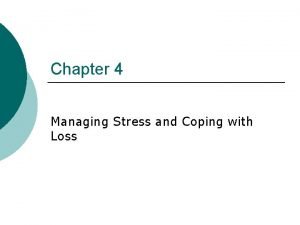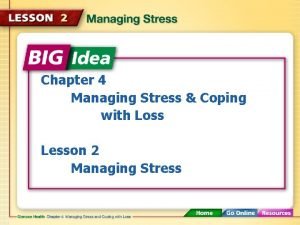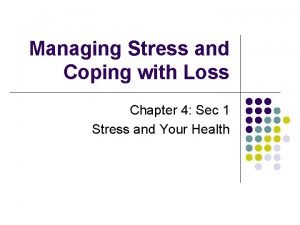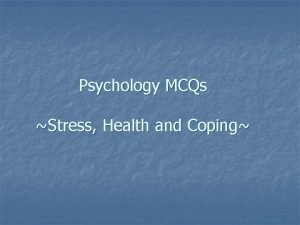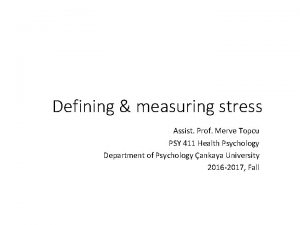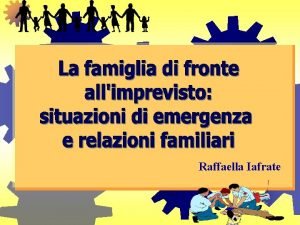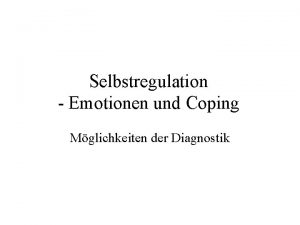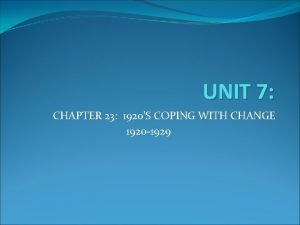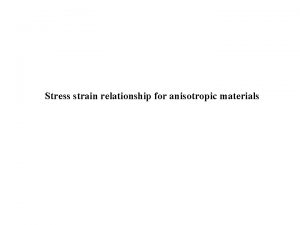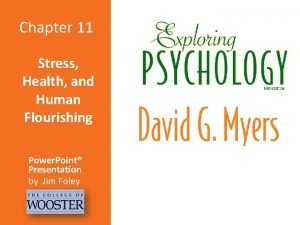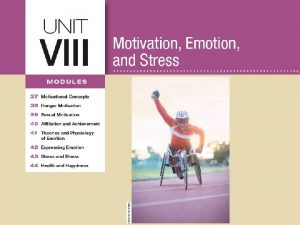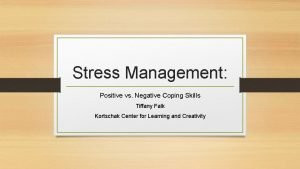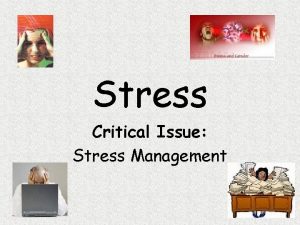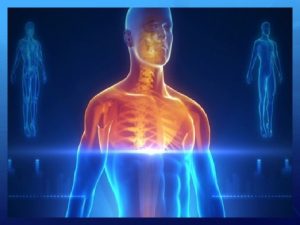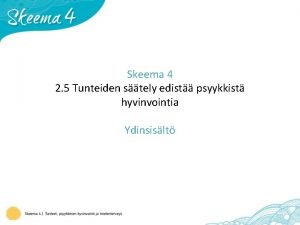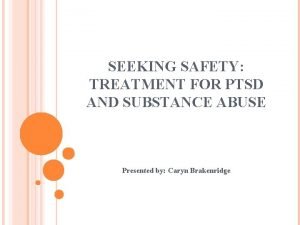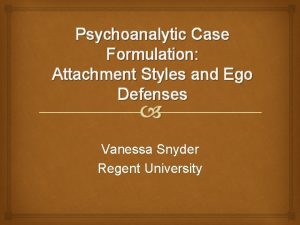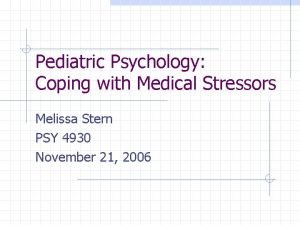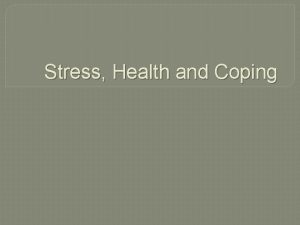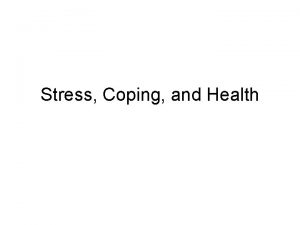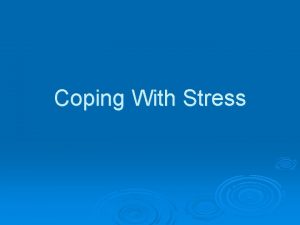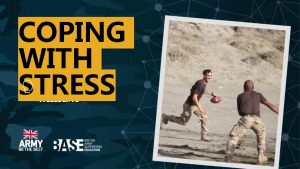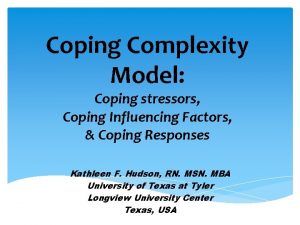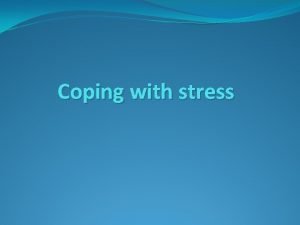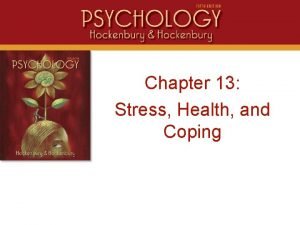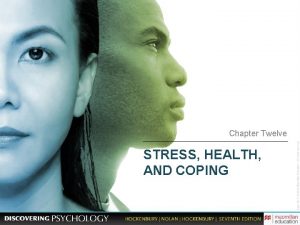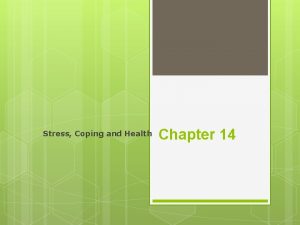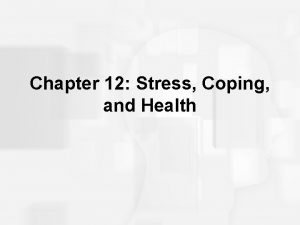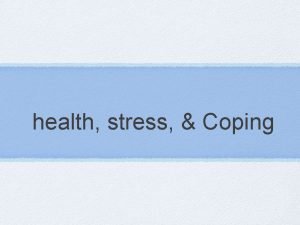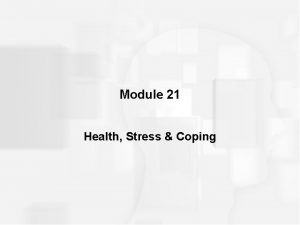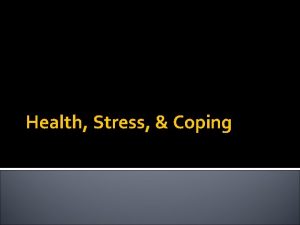Chapter 12 Stress Coping and Health The Relationship


































- Slides: 34

Chapter 12: Stress, Coping, and Health

The Relationship Between Stress and Disease • Contagious diseases vs. chronic diseases – Biopsychosocial model – Health psychology • Health promotion and maintenance • Discovery of causation, prevention, and treatment

Health and Illness • Wellness – An approach encompassing • • Lifestyle preventive care the need to maintain wellness rather than thinking of health matters only after a sickness • Biomedical Model – Explains illness solely in terms of biological factors • Biopsychosocial Model – Focuses on health as well as illness – Both are determined by a combination of biological, psychological, and social factors • Health Psychology – Devoted to understanding psychological influences on • how people stay healthy • why they become ill • how they respond when they do get ill. WWB Copyright © Allyn & Bacon 2006

The Biopsychosocial Model of Health and Stress • Focuses on health as well as on illness • Holds that both are determined by a combination of biological, psychological, and social factors. • Most health psychologists endorse this model. WWB Copyright © Allyn & Bacon 2006

Stress as an Everyday Event • Major stressors vs. routine hassles – Cumulative nature of stress – Cognitive appraisals

Holmes & Rahe’s Social Readjustment Scale 100 death of a spouse 73 divorce 65 marital separation 63 detention in jail or other institution 63 death of a close family member 53 major personal injury or illness 50 marriage 47 fired from work 45 marital reconciliation 45 retirement 44 change in health or behavior of family member 40 pregnancy 40 sex difficulties 39 gain of new family member through birth, adoption, or marriage 39 major business readjustment 38 change in financial state 37 death of close friend 36 change to a different line of work 35 change in number of arguments with partner 31 taking on a new mortgage 30 foreclosure on a mortgage or loan WWB 29 29 29 28 26 26 25 24 23 Change in responsibilities Son/daughter leaves home Trouble with in-laws Outstanding personal achievement Partner begins/stops work Starting or finishing school Change in living conditions Revision of personal habits Trouble with boss 20 20 20 19 Change in working hours or conditions change in residence change in schools Change in recreational habits 19 18 17 16 Change in church activities Change in social activities Major purchase such as a new car Change in sleeping habits 15 15 Change in number of family gatherings Change in eating habits 13 Vacation 12 Christmas or holiday observance 11 minor violation of the law Copyright © Allyn & Bacon 2006

Sources of Stress • Social Readjustment Rating Scale (SRRS) – – Outline of 43 life events from most to least stressful. Point value assigned to each event. Negative or positive events both cause stress. Point totals describe impact of stress and chance of illness over a two year period. – Score 150 -300 have 50% chance of stress related illness within 2 years. – Score 300 + have 80% chance of stress related illness within 2 years. • Shortcomings of SRRS include: – Individual’s coping styles not taken into account. – Good coping strategies reduce impact of each stressful event WWB Copyright © Allyn & Bacon 2006

Daily Hassles and Uplifts • Hassles • – little stressors including irritating demands that can cause more stress than major life changes. – Irritating, frustrating, distress demands of daily life – Relationship troubles – Health problems – Hectic daily schedules Amount of stress from hassles can vary from person to person. • Hassles are bettor predictors of psychological distress. • Uplifts - positive experiences which may neutralize hassles. • Uplifts for some are hassles for others WWB Ten Most Common Hassles for College Students 1. Troubling thoughts about future 2. Not getting enough sleep 3. Wasting time 4. Inconsiderate Smokers 5. Physical Appearance 6. Too many things to do 7. Misplacing or losing things 8. Not enough time to do the things you need to do 9. Concerns about meeting high standards 10. Being Lonely Copyright © Allyn & Bacon 2006

Major Types of Stress • Frustration: blocked goal • Conflict: incompatible motivations – Approach-approach – Avoidance-avoidance – Approach-avoidance • Change: having to adapt – Social Readjustment Rating Scale – Life Change Units • Pressure – Perform/conform

Making Choices • Approach-Approach – A choice between two positive alternatives. – Choosing a movie to see – Continuing a career or raising a child • Avoidance-Avoidance: – A forced choice between two negative alternatives. – Avoid studying for a test or failing a test • Approach-Avoidance – A choice that has both a good and bad alternative. – Drawn by a choice and repelled by a choice – Wanting to take a vacation but having to empty your savings account to do it WWB Copyright © Allyn & Bacon 2006

Figure 12. 2 Types of conflict

Figure 12. 3 Overview of the stress process

Responding to Stress Emotionally • Emotional responses – Annoyance, anger, rage – Apprehension, anxiety, fear – Dejection, sadness, grief – Positive emotions • Effects of emotional arousal – The inverted-U-hypothesis

Figure 12. 4 Arousal and performance

Responding to Stress • The General Adaptation Syndrome – The predictable sequence of reactions (stages) that organisms show in response to stressors – Alarm Stage • a burst of energy that aids in dealing with the stressful situation – Adrenal cortex releases hormones called glucocorticoids – Increases heart rate, blood pressure, and blood sugar levels – Resistance Stage • Intense physiological efforts to either resist or adapt – Glucocorticoids continue to be released – Length of stage based on stressor intensity and ability to adapt – Exhaustion Stage • Occurs if an organism fails in its efforts to resist the stressor – Stores of energy are depleted – Disintegration and death may follow WWB Copyright © Allyn & Bacon 2006

Responding to Stress Physiologically • Selye’s General Adaptation Syndrome – Alarm – Resistance – Exhaustion • Brain-body pathways – Adrenal gland catecholamines – Pituitary gland corticosteroids

General Adaptation Syndrome Stress Resistance Phase 1: Alarm Reaction Phase 2: Resistance (cope) Phase 3: Exhaustion

Endocrine Responses to Stress • Fight or flight preparation of body • Stress hormones—produced by adrenal glands – Adrenal medulla—catecholamines • Epinephrine and norepinephrine • Increases respiration, BP, heart rate – Adrenal cortex—corticosteroids • Release stored energy • Reduces inflammation and immune system responses

Figure 12. 5 Brain-body pathways in stress

The Immune System and Stress • Negative Effects on the Immune System – Periods of high stress are correlated with • Symptoms of infectious disease • Oral and genital herpes and mononucleosis • Susceptibility to colds and flu – – – Stress may reduce the effectiveness of vaccines Decrease levels of B and T cells Can worsen autoimmune diseases Increase illness behaviors, reporting and seeking medical care Suppresses immune system long after a stressful event is over • Increased academic pressures, poor marital relationships, severe depression, and sleep deprivation due to suppressed immune system • Severe bereavement affects physical and mental ailments up to 2 years following a partner’s death WWB Copyright © Allyn & Bacon 2006

The Immune System and Stress • Psychoneuroimmunology – A field in which psychologists, biologists, and medical researchers combine their expertise to study the effects of psychological factors on the immune system • Psychological factors are related to immune system functioning – Immune system exchanges information with the brain that can enhance or suppress it • Good Effects on Immune System – Rich social life with frequent interaction others – Close social ties to family, friends, co-workers, religious and volunteer groups WWB Copyright © Allyn & Bacon 2006

Stress and Physical Health • Psychosomatic diseases • Heart disease – Type A behavior—three elements • strong competitiveness • impatience and time urgency • anger and hostility – Emotional reactions and depression • Stress and immune functioning – Reduced immune activity

Coronary Heart Disease • Personality Type • Type A Behavior Pattern – Marked by a sense of urgency, impatience, excessive competitiveness, hostility, and anger – Involved in a chronic, incessant struggle to achieve more and more in less and less time – Considered a risk factor in heart disease Hostility is a key component of the Type-A behavior pattern. WWB Copyright © Allyn & Bacon 2006

Figure 12. 6 Anger and coronary risk

Table 12. 3 Health Problems that may be Linked to Stress

Figure 12. 7 The stress-illness correlation

Responding to Stress Behaviorally • Coping • Styles of coping – Learned helplessness – Frustration-aggression hypothesis – Self-indulgence – Defensive coping – Constructive coping

Response to Stress • Psychological Factors – Perception of control – Explanatory style – Chronic negative emotions – Hostility • Social Factors – Outside resources – Friends and family – Positive relationships

Factors Moderating the Impact of Stress • Social support – Increased immune functioning • Optimism – More adaptive coping – Pessimistic explanatory style • Positive effects

Personal Support and Stress A strong social support network can help a person recover faster from an illness. WWB Copyright © Allyn & Bacon 2006

Personal Factors Reducing The Impact of Stress and Illness • Optimists – – – Cope more effectively with stress Reduces risk of illness Generally expect good outcomes Find positives even in the darkest circumstances Generally more stress resistant • Pessimists – Expect bad outcomes – Hopelessness • Moderate to high levels died from all causes at two to three times the rates WWB Copyright © Allyn & Bacon 2006

Health-Impairing Behaviors • • Smoking Poor nutrition Lack of exercise Transmission, misconceptions, and prevention of AIDS

Figure 12. 8 The prevalence of smoking in the United States

Reactions to Illness • Seeking treatment – Ignoring physical symptoms • Communication with health care providers – Barriers to effective communication • Following medical advice – Noncompliance
 Chapter 4 managing stress and coping with loss notes
Chapter 4 managing stress and coping with loss notes Chapter 4 managing stress and coping with loss lesson 1
Chapter 4 managing stress and coping with loss lesson 1 Chapter 4 managing stress and coping with loss
Chapter 4 managing stress and coping with loss Chapter 4 managing stress and coping with loss
Chapter 4 managing stress and coping with loss Stress management mcqs
Stress management mcqs Stress appraisal and coping
Stress appraisal and coping Family stress and coping
Family stress and coping Stress strain coping support model
Stress strain coping support model Coping strategies for exam stress
Coping strategies for exam stress Stress strain coping support model
Stress strain coping support model Chapter 10 stress responses and stress management
Chapter 10 stress responses and stress management Coping saw health and safety
Coping saw health and safety Jeopardy mental health
Jeopardy mental health Lesson 3 coping with loss and grief
Lesson 3 coping with loss and grief True stress vs engineering stress
True stress vs engineering stress Calvin coolidge
Calvin coolidge Axial normal stress
Axial normal stress Stress strain relationship for anisotropic materials
Stress strain relationship for anisotropic materials Chapter 3 health wellness and health disparities
Chapter 3 health wellness and health disparities Glencoe health chapter 1 understanding health and wellness
Glencoe health chapter 1 understanding health and wellness Understanding your health and wellness chapter 1
Understanding your health and wellness chapter 1 Stress health and human flourishing
Stress health and human flourishing Module 43 stress and health
Module 43 stress and health Importance of relationship marketing
Importance of relationship marketing Marianna virtanen
Marianna virtanen Coping technikák
Coping technikák Positive vs negative coping skills
Positive vs negative coping skills Problem-focused coping examples
Problem-focused coping examples Coping mechanism projection
Coping mechanism projection Defenssit ja coping-keinot
Defenssit ja coping-keinot Seeking safety worksheets
Seeking safety worksheets Green roof parapet detail
Green roof parapet detail Secure attachment style
Secure attachment style Melissa stern psychologist
Melissa stern psychologist Nursing interventions for ineffective coping
Nursing interventions for ineffective coping

